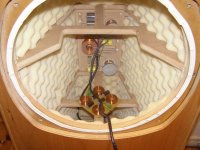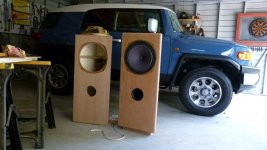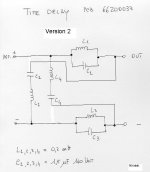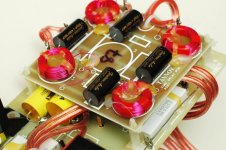Hey Jean and others,
Any news on the quest for the perfect 'small' enclosure. I am still thinking Onken, R-GRF or aperiodic design (closed with flow restricted vent). I am using the aperiodic design with HPD385A and the bass is tight and well controlled (IMHO)
Jesper
Sorry i didn't get back to you. Over two years is rather a long time. Here is a thread with my design and the pictures at the end with a bigger view. I will be happy to give you help if needed. Jim.
http://www.diyaudio.com/forums/multi-way/164456-12-tannoy-monitor-golds-onken-cabinets.html
Hi all,
Time flies and now I am finally getting ready to build the cabs. As I mentioned it will be with reconed Tannoy 3808 => 3838 (HE surround) with new HF diaphragms and the filters will be based on Phil Short's redesign.
Cabs will be either 140l (int) Aperiodic Design or the Onken design.
For info about aperiodic see here:
Aperiodic Loudspeaker Enclosure Design
Today I am using 3 vents with my Tannoy Berkeley HPD385A and this is much much better than the closed design. I suppose I will need 4 or maybe even 5 vents for the 3838...
Jim, what kind of calculations/tests did you go though to get the final design?
Thanks
Jesper
Time flies and now I am finally getting ready to build the cabs. As I mentioned it will be with reconed Tannoy 3808 => 3838 (HE surround) with new HF diaphragms and the filters will be based on Phil Short's redesign.
Cabs will be either 140l (int) Aperiodic Design or the Onken design.
For info about aperiodic see here:
Aperiodic Loudspeaker Enclosure Design
Today I am using 3 vents with my Tannoy Berkeley HPD385A and this is much much better than the closed design. I suppose I will need 4 or maybe even 5 vents for the 3838...
Jim, what kind of calculations/tests did you go though to get the final design?
Thanks
Jesper
Hi jesper
You need to download an Onken calculator and play with the settings to get the port length with relation to speaker size. Also find the parameters of the drivers and input them into the calculator . I did get help with this from algorth a member. Jim.
You need to download an Onken calculator and play with the settings to get the port length with relation to speaker size. Also find the parameters of the drivers and input them into the calculator . I did get help with this from algorth a member. Jim.
ONKEN_CALC | Scribd
tannoy
Here are the sites you need. If I can help will only be to pleased but I am sure someone will help us out.
tannoy
Here are the sites you need. If I can help will only be to pleased but I am sure someone will help us out.
Can I add some personal experience with Tannoy 15" drive units. Back in the day when I were a lad, I just stuck them in a 3 cubic foot PA box with a couple of 3"x1" reflex holes and some spongey cabinet lining and a volume of Kapok cushion filling. Not anything like as good as this:
The disco was going well until I realised that the disco room was filling with fluffy Kapok. 😱
Every bass note was puffing the damn stuff into the room. 😱
I dumped the Kapok on subsequent nights, but the fact is that those old Tannoy's were about the best sounding speaker I have ever heard. They are incredibly unfussy about enclosures. The easiest build of my life. 😀
An externally hosted image should be here but it was not working when we last tested it.
The disco was going well until I realised that the disco room was filling with fluffy Kapok. 😱
Every bass note was puffing the damn stuff into the room. 😱
I dumped the Kapok on subsequent nights, but the fact is that those old Tannoy's were about the best sounding speaker I have ever heard. They are incredibly unfussy about enclosures. The easiest build of my life. 😀
Last edited:
110L 3839
Just finished my "Sync Source" or time delay boards for my modified "Puma" drivers with 3839 recones in a 110 liter reflex tuned to 35 Hz.
I also own an original pair of Berkeleys with the alnico HPD 385 .
The 3839 seems to go a little deeper and at high SPL they sound less fatique .
After fitting the Time delays , the stereo image is better , but the Berkeleys are better at low volume .I have eagle files available for sharing .
thanks to speakerbug.com.au for their exelent parts .
Just some personal experience ,
Tannoy Berkeley on Luxman L-590 7 out of 10
Tannoy Berkeley on Dynaco stereo 400 6 out of 10
Tannoy Berkeley on LJM L15D 8 out of 10
Tannoy 3839 on LJM L15D 10 out of 10
Tannoy 3839 on Dynaco stereo 400 9 out of 10
Tannoy 3839 on Luxman L-590 10 out of 10
Just finished my "Sync Source" or time delay boards for my modified "Puma" drivers with 3839 recones in a 110 liter reflex tuned to 35 Hz.
I also own an original pair of Berkeleys with the alnico HPD 385 .
The 3839 seems to go a little deeper and at high SPL they sound less fatique .
After fitting the Time delays , the stereo image is better , but the Berkeleys are better at low volume .I have eagle files available for sharing .
thanks to speakerbug.com.au for their exelent parts .
Just some personal experience ,
Tannoy Berkeley on Luxman L-590 7 out of 10
Tannoy Berkeley on Dynaco stereo 400 6 out of 10
Tannoy Berkeley on LJM L15D 8 out of 10
Tannoy 3839 on LJM L15D 10 out of 10
Tannoy 3839 on Dynaco stereo 400 9 out of 10
Tannoy 3839 on Luxman L-590 10 out of 10
Attachments
You do know that the SyncSource time delay was just a marketing gimmick to keep up with the Joneses?
The timing difference between tweeter and woofer is about 6 microsecs, much lower than humans can hear and even Tannoys own engineers have been on record (albeit much later on) that it is actually detrimental to the sound quality of the driver.
The timing difference between tweeter and woofer is about 6 microsecs, much lower than humans can hear and even Tannoys own engineers have been on record (albeit much later on) that it is actually detrimental to the sound quality of the driver.
I can hear a difference , and my ears are quite old , I did an A/B test with a switch and it is significant , I dont agree with your timing assumptions ,even with your fancy name , I did some measurements , not micro's but mili's , have to document them but come back on this .
Cheers ,
Rens
Cheers ,
Rens
.....I have eagle files available for sharing ........
feel free to share just schmtc , no need for Eagle files
I have that , but another (proofed) as confirmation , can't do any harm
I have plan in next few months to finish MLTL cabz for my K3809
tnx !
and , now , just for the public - one still missing info all around the net - where exactly that circuit is connected .............
TIA
(please - don't mix any of these spks with Picado board !
 )
)
and , now , just for the public - one still missing info all around the net - where exactly that circuit is connected .............
TIA
(please - don't mix any of these spks with Picado board !
 )
)cut your tweeter wires and connect to the board , connect the tweeter wires to the other side of the board . Just mount this circuit between your HF see the schematic
will make a thread , when tested ......... in fact - I'll post here , on Tannoy Yahoo Group and on Quarter Wave Yahoo Group
unfortunately - have some other things to do in a meantime
MLTL calculated with MJK software - Quarter Wavelength Loudspeaker Design
unfortunately - have some other things to do in a meantime
MLTL calculated with MJK software - Quarter Wavelength Loudspeaker Design
I can hear a difference , and my ears are quite old , I did an A/B test with a switch and it is significant , I dont agree with your timing assumptions ,even with your fancy name , I did some measurements , not micro's but mili's , have to document them but come back on this .
Cheers ,
Rens
You can always calculate it.
Its been awhile since I had mine out of their cab but with the K-series drivers the distance between the voice coils can't be much more than 3cm or so.
The AlNiCo drivers with their much deeper magnet structures had the tweeter coil exactly 1/4 of the xover frequency behind. Taking the phase shifts induced by the xover into account the output was in phase but not in time ie shifted by one cycle. K-series are neither but the mismatch is a lot smaller.
My Little Reds are early ones and never had the SyncSource fitted.
Consequently I got curious about its possible benefits and joined the Tannoy Yahoo group which is where I learned about its origin and that their design engineer is on record as saying that the SyncSource circuit creates more problems than it solves but at the time time alignment was The buzzword in the States and that was their main market . Lockwood Audio also advised not to bother with it for similar reasons.
It gels nicely with my experience that inductors in the signal path are best kept to a minimum. To my ears they are substantially more detrimental to SQ than caps hence I now run my speakers active.
Also to my ears timing discrepancies always sounded worse when the tweeter is in front of the woofer (as in your standard dome-cone box) than behind by a similar distance (as with a horn midtweeter-cone box).
I have no idea why though…
Resurrecting an old thread... Just got a pair of lovely SRM12X with the syncsource.
I read that these speakers sound better with no syncsource engaged, but would like to have your opinions before I go on and remove it.
How much "better" would they sound, if at all?
I read that these speakers sound better with no syncsource engaged, but would like to have your opinions before I go on and remove it.
How much "better" would they sound, if at all?
- Home
- Loudspeakers
- Multi-Way
- "Small" enclosure for Tannoy 15"




